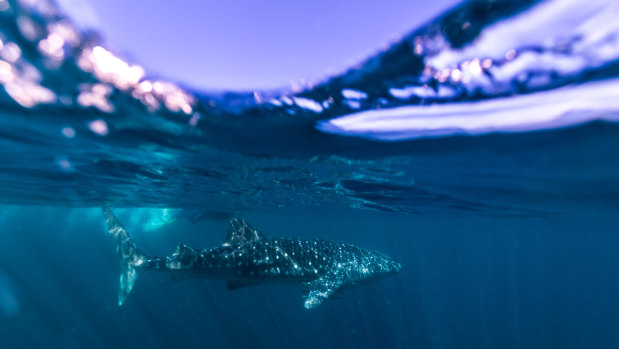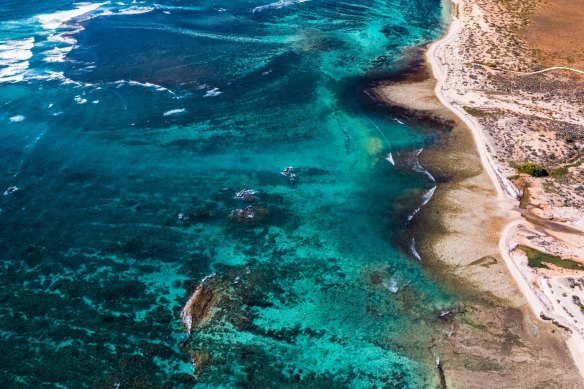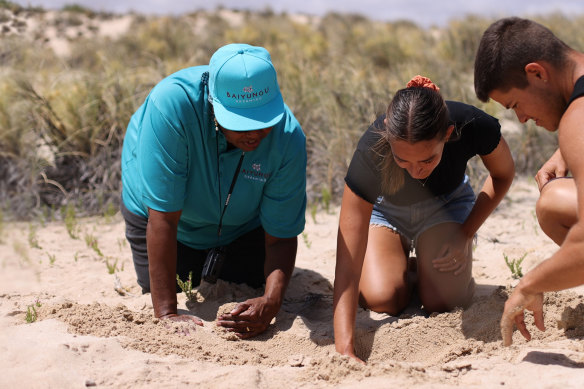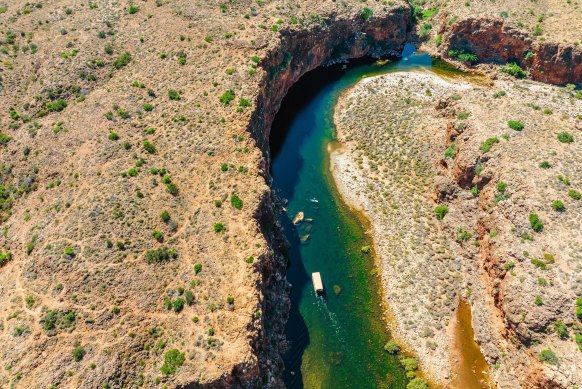A spine-tingling trip back in time in the home of the world’s biggest shark
By Anabel Dean
Hazel Walgar stands on a sandy escarpment hemmed by one of the last intact arid-zone estuaries in the world. Ningaloo (Nyinggulu) reef dangles at her fingertips.
“Ngarri Yinhaya Baiyungu,” she says. Welcome to the traditional lands of the Baiyungu people. “We’re speaking to the spirits and letting them know we’re taking you fellas on country, just having a look, not to harm but to protect us.”
Unscrolled, right in front of us, an insanely gorgeous fringing reef quivers with life for 300 kilometres along Western Australia’s coral coastline.
“We’re proud to share this place with the world,” says Hazel, words voiced as a representative of the oldest Indigenous civilisation with connection to country spanning tens of thousands of years.

Swimming with the biggest fish in the sea – the whale shark.Credit: Tourism WA
The Ningaloo experience is emotionally significant for many people in ways that cannot easily be explained. Visitors gather on the jetty for a boat ride to the outer edge of the reef where they will swim with the largest fish in the sea, the toothless plankton-trolling whale shark, but there are World Heritage riches closer to the shoreline.
This is the birthing place of humpback whales; the foraging ground of endangered dugongs. There are orcas, dolphins, turtles, manta rays, reef sharks with wrasses darting between teeth, vibrant corals and globular sponges. More than 500 species of fish lie beneath this incandescent cobalt water now ruched by a brisk breeze.
“Got your snorkel and flippers?” asks Hazel.
She climbs into a battered 4WD vehicle and disappears in a cloud of white dust with husband, Gav, behind the steering wheel. The Baiyungu Dreaming expedition is the only Indigenous tour on the Ningaloo Coast, leading visitors off-road to places that cannot otherwise be accessed, on country managed jointly by traditional owners and Western Australia’s Parks and Wildlife Service.
This is the first Aboriginal tourism experience to be offered in the region traditionally owned by Jinigudera, Baiyunga and Thalanyji people.

The Ningaloo Reef coastline near the North Mandu campground.Credit: Scott Slawinski
First stop, a shell midden in the sand dunes, signs of early Aboriginal occupation. Recent archaeological excavations have confirmed First Nations people were living here at the time of colonisation.
“The archaeologists seem to think that because we’re the closest to the continental shelf, we could be the oldest First People, dating back at least 65,000 years,” Hazel says. The jaw bone of the Tasmanian tiger – the Thylacine – was found in a fire-pit. “And you probably know about the shell bead necklace?”
One of the most ancient pieces of jewellery in the world – a spine-tingling 32,000 years old – the necklace was found by Hazel’s brother at nearby Mandu Mandu in the Cape Range. It’s in Perth’s Western Australian Museum now.
“I want to get more carbon dating done here,” says Hazel, flicking over bone-white shells part-buried in sand. “We’re stepping into their dining rooms here,” she says, lifting a grinder stone used as mortar and pestle in a long-ago dune kitchen.
You’d perish here, where the desert slides into the sea, if you didn’t know Country. Gav starts digging into the sand with a smooth spiral-coiled bailer shell, searching for the submerged year-round spring that filters fresh water through limestone, slowly leaching out into the bay. Within seconds, water is gushing from gritty layers, into a hole barely as deep as his elbow.
“Wait till it settles then it’s clean to drink,” Gav says. A sip from the shell is slightly salty but surprisingly palatable. “Now cover it up again,” Hazel directs. “The hole is only open in our culture for when we are ready to go down to die.”
We’re off again, bumping and sliding on a soft-wheeled roller-coaster, pausing at ancient feasting sites, enthralled by the parrot fish dentures scattered like small finger nails high on a hill. Finally, at the point where turquoise ocean meets curved beach, Hazel pulls up her camp chairs.

Water from the dunes.Credit: Tourism WA
“This five-fingered reef is a dreaming site for the octopus,” she says, body buried in land, tentacles out in sea.
With flippers and snorkel, we are floating on the edge of an abyss, the edge of the continental shelf, trailing through a liquorice all-sorts of small fins into a school of electric Damsel fish agitating for attention. We’re burbling joyously through plastic air pipes, pointing at the purple tipped stag corals and the rounded brownish brain corals, layer upon layer jostling for sunlight above visible sea floor.
Up ahead there’s a turtle, head popping from water for air, gulping for breath then flipping feet backwards, dancing down into the depths. Angelfish, clownfish, starfish, a ray whipping up sand eddies while it feeds. We shuffle back onto the beach, tingling with the pleasures of sun and sea, discovering an intimacy with culture while listening to another story.
We draw closer for the yarns. Yarning brings understanding. Healing. Respect.
Hazel was one of the stolen generations. Like her sisters and her husband, she was taken to a mission at six years of age, banned from speaking in her own tongue. She refused to sever connection with place, language, culture. Her way of being in this place is testament to a resilient bond to country where time is written in shells across six seasons, not four.
She talks of life away from the coast, out past the towering termite mounds, where beach collides with bush and the ancient sea floor has been thrust upwards in the red-throated ravines of The Cape Range National Park.

Yardie CreekCredit: Tourism Western Australia
Up among the mangrove forests, at Yardie Creek, small fry are beginning life before moving into the open waters of the reef. On land, where the stones are jewelled with fossilised corals, there are black-flanked rock wallaby, dingoes, flying fox and nesting osprey.
It’s another precious ecosystem with a richness and scale that affords hope for the future as a refuge of ageless isolation. “I’ve got a passion for sharing love of this place,” Hazel says again, finally.
Welcome to my country.
THE DETAILS
Visit
The town closest to the World Heritage listed Ningaloo Marine Park and adjacent Cape Range National Park is Exmouth, 125 kilometres up the coast from Perth and a base for recreational fishing and dive charters. See westernaustralia.com/au
Stay
Mantarays Ningaloo Beach Resort is the only resort on Sunrise Beach, Exmouth, and a congenial base for explorations across Ningaloo Reef and Cape Range National Park. See mantaraysningalooresort.com.au
Experience
Baiyungu Dreaming Tagalong Tour provides insights with traditional custodians of the World Heritage-listed Ningaloo Coast. Cost is $249 a vehicle (driver and passenger) and $50 for each additional adult or $20 children (6-16 years). There are also sunset campfire tours on the Indigenous-run Carbadia Station. See baiyungudreaming.com.au
The writer was a guest of Qantas and Tourism Western Australia.
Sign up for the Traveller Deals newsletter
Get exclusive travel deals delivered straight to your inbox. Sign up now.